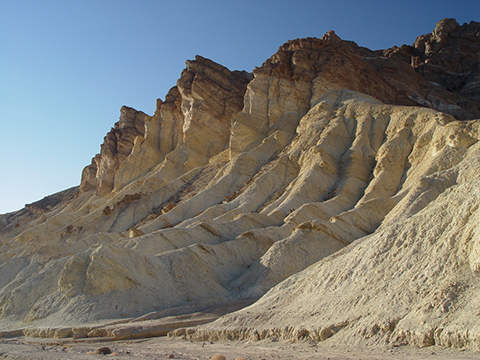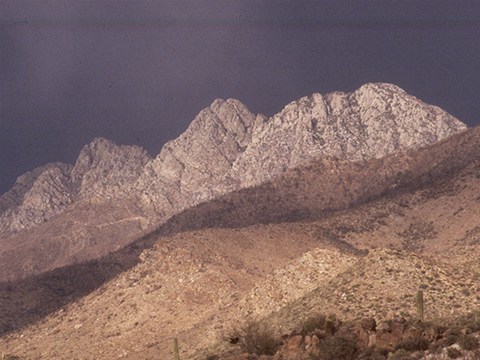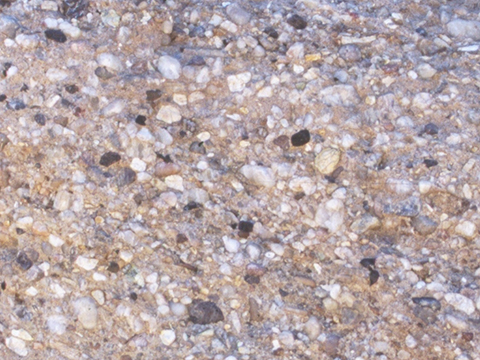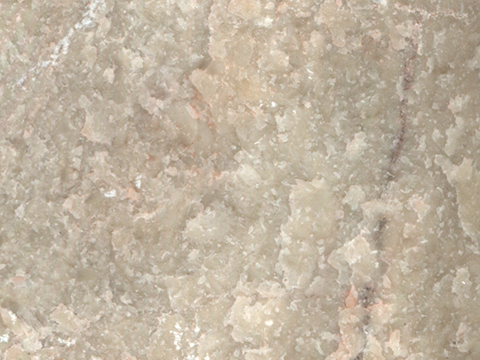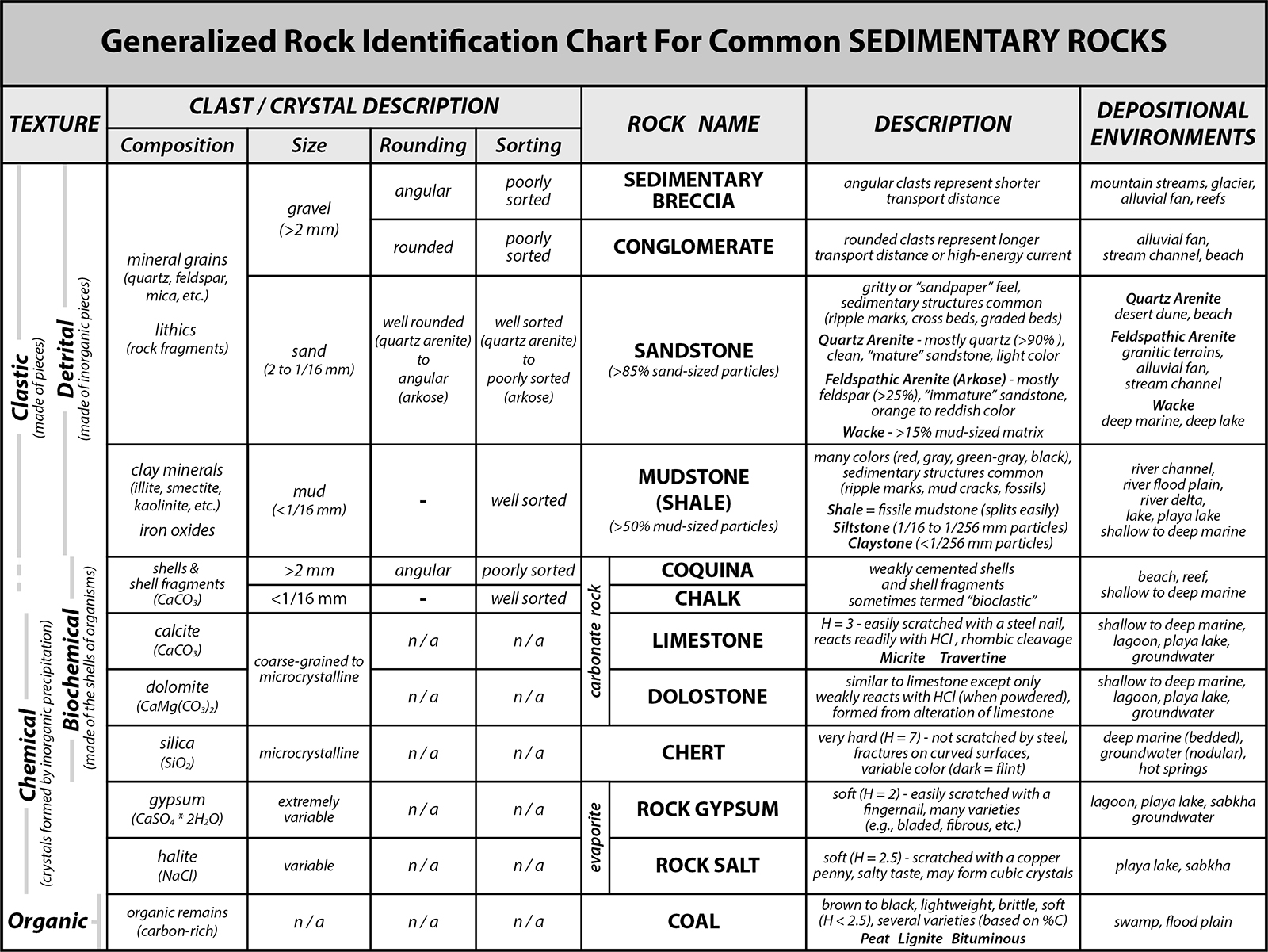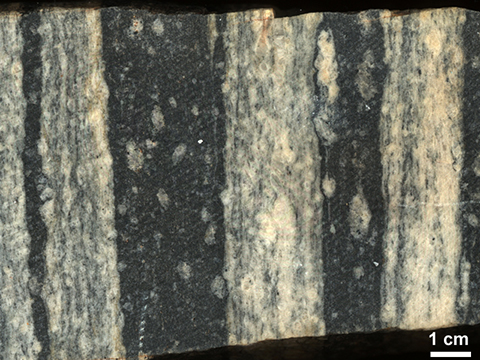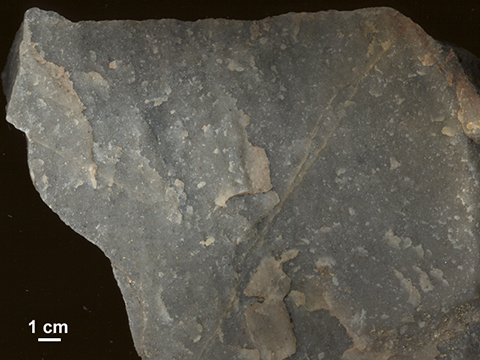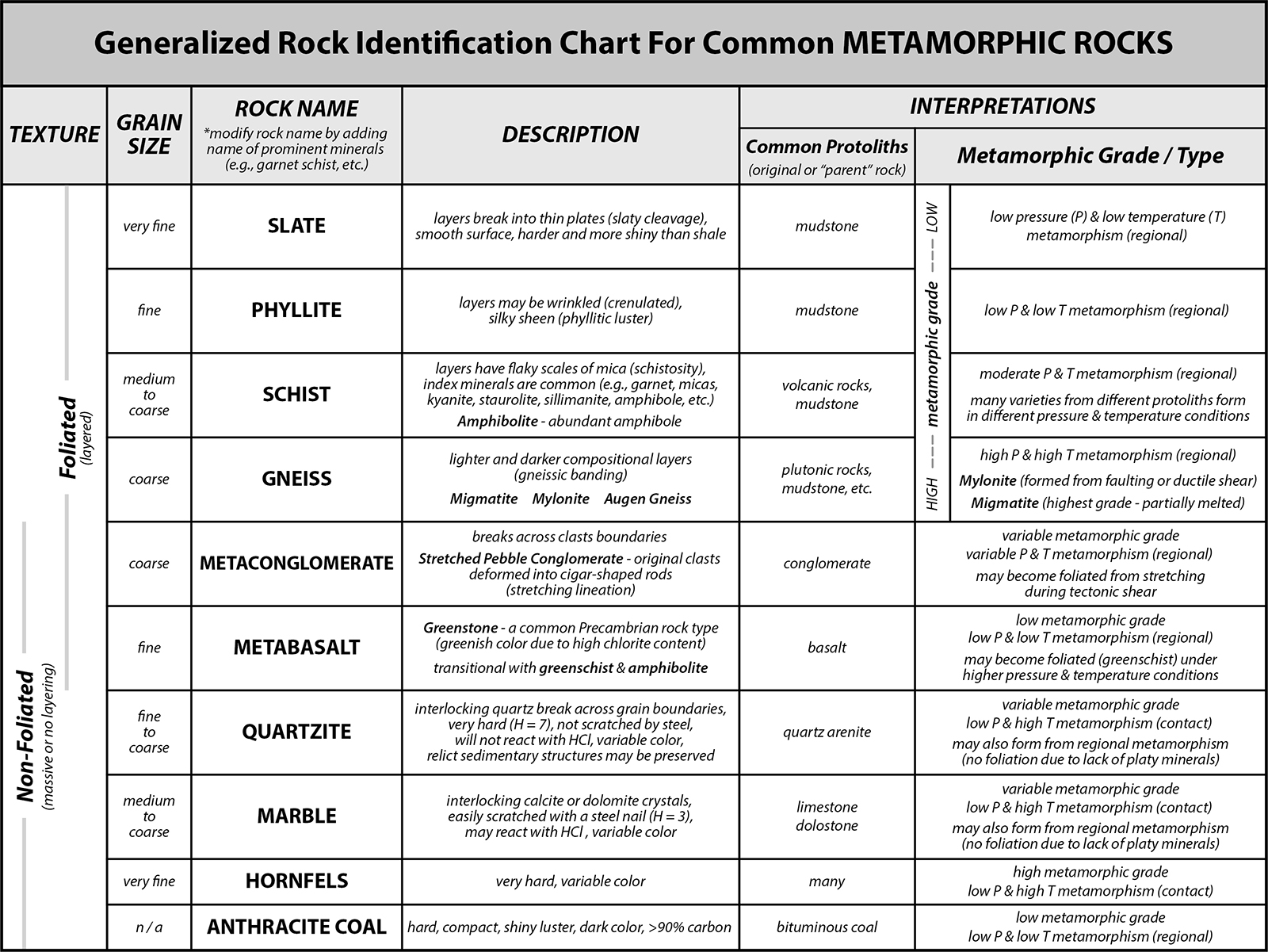Part C
Sedimentary & Metamorphic Rocks
Sediment is formed by the mechanical and chemical weathering of rocks on Earth's continents. Biologically produced microscopic shell material is also a major source of sediment. Processes of flowing water, blowing wind, and moving ice distribute this debris across much of Earth's surface, including environments such as river flood plains, beaches, desert sand dunes, or the bottom of the ocean.Compaction and cementation of sediment over time represents the process of lithification, and sedimentary rocks are born (see Figure 4-10). Because sedimentary rocks were once sediments, they record the surface conditions of the past, like where they originated, how far they were transported, when and where they were deposited, etc.
Metamorphic rocks form from pre-existing igneous, sedimentary, or metamorphic rocks due to an increase in temperature, pressure, and/or fluids. Changes that occur during metamorphism occur while the rock is solid (no melting occurs). Increasing temperatures will progressively recrystallize the minerals in rocks, and makes them harder and denser than the original rock (See Figure 4-10). For instance, if limestone (parent sedimentary rock) is buried and exposed to high temperatures, it will form a new rock called marble (metamorphic rock). Metamorphic rocks and structures commonly form at depth within the Earth, and we see the results metamorphism only after the rocks are uplifted and exposed at the surface. By observing these features at the Earth's surface, we can infer the nature and origin of past tectonic forces that are typically associated with mountain-building events.
|
Figure 4-10. Along with igneous rocks, sedimentary and metamorphic rocks complete the geologic rock trifecta. Sedimentary rocks of Golden Canyon in Death Valley National Park (left). |
|
Sedimentary Rocks
Sedimentary rocks can form from loose sediment of various sizes derived from preexisting rock, from mineral crystals (i.e., quartz or calcite) that precipitate out of water or from the accumulation of organic material. There are two main types of sedimentary rocks, clastic and chemical, both based on their texture (see Figure 4-11).Clastic sedimentary rocks are made of pieces (called grains or clasts) and are cemented together with calcite, quartz, clay, etc. For non-clastic rocks, you need to determine the composition of the mineral crystals in the rock. These rocks include chemical sedimentary rocks usually formed from the precipitation or evaporation of water at/near the Earth's surface. Biochemical sedimentary rocks form as a result of biological activity and typically consist of shell material of various sizes. Organic sedimentary rocks form largely from the accumulated remains of organic material. As with the igneous rocks, field identification and interpretation of sedimentary rocks requires knowledge of both the texture and composition of the rock.
|
Figure 4-11. Clastic and chemical sedimentary textures. Clastic textures are composed of discrete pieces (left), whereas chemical textures are composed of crystals (right). |
|
Sedimentary Textures
Clastic Textures
Clastic sedimentary rocks are ones made of sediment or broken pieces (clasts or fragments) of other rock. Clasts can range in size (fine to coarse), shape (rounded or angular), and sorting (variation in grain size). If you think a rock has this texture, then you can describe it just like clastic sediment.
> Clast size - Are the clasts gravel-sized (>2 mm), sand-sized (2 mm to 1/16 mm), or mud-sized (<1/16 mm)? If it's really hard to see individual clasts, then it's probably mud-sized (silt or clay).
> Clast sorting - Are the clasts mostly the same size (well sorted) or different sizes (poorly sorted)?
> Clast rounding - Are the clasts mostly rounded or angular?
A few notes:
> Being able to distinguish between a fine-grained clastic rock and a fine-grained crystalline rock is not always easy because the grains or crystals are so small. You'll need some other clues in this case.
> To accurately name the rock, look at a representative part of the rock. Look at the size, rounding, and sorting of the majority of clasts in a rock, not just a few.
> The particles in a clastic rock are typically cemented together by minerals deposited by groundwater processes (during burial and lithification). Common cements include silica (especially in silica-rich sandstones), calcite, iron oxide, etc. The degree of cementation can vary.
Chemical Textures
Not all sedimentary rocks are made of pieces. Chemical sedimentary rocks commonly have a crystalline appearance and are classified based on their mineral composition. If you think a rock has chemical texture, then you need to use a combination of physical properties (hardness, HCl acid test, color, etc.) to identify the mineral composition of a rock. The hardness test involves scrathing a rock with a steel nail, your fingernail, etc. to determine relative hardness. The HCl acid test is employed to produce an effervescent ("fizzing") reaction with carbonate rocks. A few drops of the dilute hydrochloric acid won't harm you if you get it on your fingers, just don't get it in your eyes or mouth.
Some common mineral compositions and their properties include:
> Calcite - H = 3, so it can be scratched with a steel nail. It will also "fizz" with HCl acid. Calcite can be any color. This is a common cement between grains in a clastic rock.
> Silica - H = 7, so it cannot be scratched by a steel nail. It will not "fizz" with HCl acid. Silica can be any color. This is a common cement between grains in a clastic rock.
> Dolomite - Essentially the same as calcite, except that it will not react with HCl acid as easily (unless powdered).
> Gypsum - H = 2, so it can be scratched with your fingernail. It will not "fizz" with HCl acid. Gypsum is typically clear to white in color. It breaks into distinctive rhombic sheets as well.
> Halite - H = 3, so it can be scratched with a steel nail, but not your fingernail. It will not "fizz" with HCl acid, but it does have a "salty" taste (I don't recommend licking the rocks). Halite is typically clear to white in color. Where free-growing, it can form cubic crystals.
A few notes:
> Any rock can "fizz" with HCl acid if it has any calcite in it or on it. Make sure you apply the acid to a fresh, representative surface because calcite is a common surficial mineral deposited by groundwater. Also, clastic rocks (like sandstone, conglomerate, etc.) can "fizz" with HCl acid if their clasts are made of calcite or if the cement binding the clasts together is composed of calcite (which is common).
> As the amount of dolomite and calcite in a carbonate rock can be variable, so can the degree of "fizzing". Becase of the different relative proportions of the two minerals, some limestones will react vigorously, so less so. The same is true for dolostones, where some will not react at all and some will weakly react. The "tweener" rocks with the intermediate reactions may be called dolomitic limestones or limey dolomites.
Common Sedimentary Rocks
> A clastic sedimentary rock made mostly of angular pieces of gravel-sized (>2 mm) sediment. Typically poorly sorted.
> It may or may not react with HCl acid, depending on the composition of the clasts and cement.
> Depositional environments include mountain streams, alluvial fans, glaciers, and reefs.
> Arizona examples - The buttes of Papago Park and the "head" of Camelback Mountain.
> A clastic sedimentary rock composed of rounded pieces of gravel-sized (>2 mm) sediment.
> They may or may not react with HCl acid, depending on the composition of the clasts and cement.
> Common depositional environments include stream channels, alluvial fans, and beaches.
> Arizona examples - Shinarump Conglomerate (northern Arizona); Barnes Conglomerate, "basin-fill" in central and southern Arizona.
> A clastic sedimentary rock mostly made of sand-sized (2 mm to 1/16 mm) sediment.
> There are several compositional types of sandstone. Quartz arenite is composed of mostly quartz grains (>90%), feldspathic arenite (arkose) has more feldspar, and wacke has >15% clay-sized material.
> Sorting and rounding may vary, and can show well-defined layering (bedding).
> Because of their sand-sized clasts, sandstones may feel "gritty" or like sandpaper. They may or may not react with HCl acid, depending on the composition of the clasts and cement. Although commonly composed of a lot of highly resistant silica, sandstone is typically scratched with a steel nail.
> Sedimentary structures commonly include cross bedding, graded bedding, and ripple marks.
> Depositional environments include stream channels, flood plains, river deltas, desert sand dunes, beaches, etc.
> Arizona examples - Coconino Sandstone, Navajo Sandstone, etc. form buttes and cliffs in northern Arizona.
> A clastic sedimentary rock composed of >50% mud-sized (< 1/16 mm) particles, including silt (1/16 mm to 1/256 mm) and clay (< 1/256 mm).
> Mudstone composed of clay-sized grains and breaks apart in layers is called shale or claystone ; if the particles are silt-sized, the rock is called siltstone.
> Mudstone may or may not react with HCl acid, depending on the composition of the cement. It is also typically scratched with a steel nail.
> Sedimentary structures commonly include dessication cracks (mud cracks) and ripple marks.
> Environments of deposition include, flood plains, river deltas, playas, lakes, shallow and deep marine.
> Arizona examples - Bright Angel Shale, Hermit Formation, Chinle Formation, Mancos Shale, etc. are common slope-formers in northern Arizona.
> Many different varieties of carbonate rock mainly composed of the mineral calcite (calcium carbonate).
> Can be chemical (precipitation of calcite crystals) or biochemical (composed of shells of organisms) in origin.
> Limestone reacts with HCl acid and can be scratched with a steel nail.
> Sedimentary structures commonly includes fossils.
> Typically deposited in lakes or marine environments. Travertine is limestone deposited in caves or springs.
> Arizona examples - Redwall Limestone, Escabrosa Limestone, etc. are cliff-forming units in Arizona.
> A chemical sedimentary rock very similar to limestone, but is composed mainly of the mineral dolomite.
> Dolostone is also referred to as dolomite.
> Like limestone, dolostone may be chemical or biochemical in origin.
> Dolostone will not react with HCl acid (unless powdered), but like limestone, dolostone can be scratched with a steel nail.
> Typically forms as Mg-rich brines (very salty water) replace the calcium in limeston.
> Common depositional environments include arid lakes and playas (dried-up lakes), lagoons, sabkhas (coastal salt flats), and shallow marine environments.
> Arizona examples - Martin Formation (central Arizona); many named limestone units also include dolostone.
> A chemical sedimentary rock mainly composed of microcrystalline silica (quartz).
> Chert can be chemical (precipitation of silica crystals) or biochemical (composed of microscopic animal shells) in origin.
> Chert does not react with HCl acid. It is very hard (H = 7) and cannot be scratched with a steel nail.
> Can form by groundwater processes or in deep marine environments.
> Arizona examples - Chert beds and nodules are locally abundant in carbonate rocks across Arizona.
> Chemical sedimentary rocks that form from the evaporation of water.
> There are several different kinds of evaporites, including rock gypsum (gypstone) and rock salt.
> Neither gypstone nor halite will react with HCl acid and can be scratched with a steel nail. Both can be scratched with a steel nail. Gypstone (H = 2) can be scratched with your fingernail, whereas halite (H = 3) is harder to scratch with your fingernail, if at all. Gypsum crystals have distinctive cleavage and halite crystals form cubes when free-growing.
> Common depositional environments include playas (dried-up desert lakes) and sabkhas (arid tidal flats).
> Arizona examples - Luke Salt (west Phoenix, subsurface); various playas across Arizona (Willcox, Red Lake), several northern Arizona rock units (Toroweap Formation, Kaibab Formation, Moenkopi Formation, etc.).
> An organic sedimentary rock formed from carbon-rich matter buried in ancient swamps.
> Coal is typically black in color and is brittle.
> Common depositional environments include swamps and marshes.
> Arizona examples - Mesa Verde Group (Black Mesa, northeastern Arizona).
Identifying Sedimentary Rocks
In classifying a sedimentary rock, you first look at its appearance (texture): is it made of pieces (clastic) or is it made of interlocking crystals that grow together (crystalline)? If clastic, then determine the size, rounding, sorting, and composition (if possible) of the clasts. If crystalline, determine the composition of the crystals. Then refer to the sedimentary rock identification chart below to name the rock (Figure 4-12).
|
IF THE ROCK IS CLASTIC |
IF THE ROCK IS CHEMICAL / BIOCHEMICAL / ORGANIC |
|
Clast Size (mud, sand, or gravel) |
Composition (calcite, dolomite, silica, gypsum, halite, carbon-rich, etc.) |
|
Clast Shape (rounded or angular) |
Rock Name (see chart) |
|
Clast Sorting (well sorted or poorly sorted) |
Depositional Environment (see chart) |
|
Rock Name (see chart) |
|
|
Depositional Environment (see chart) |
|
|
Figure 4-12. A rock identification chart for common sedimentary rocks. Click on the image to see a larger JPEG version. |
* IMPORTANT *
Using the PDF link above, print a hard-copy version of this chart for use in this lab and the lab quiz.
Refer to the sedimentary rock identification chart and the rock descriptions to answer Quiz Me! questions C26 through C36.
![]()
![]()
![]()
![]()
![]()
![]()
Metamorphic Rocks
Metamorphism can create new rocks form from pre-existing rocks based on the pressure, temperature, and the fluid activity in the rock. Metamorphic rocks are formed from some original rock type (igneous, metamorphic, or sedimentary) and are referred to as the parent rock (protolith). For instance, if a limestone (protolith) is buried and exposed to high temperatures, it will form a new rock called marble (metamorphic rock). Depending on the degree or intensity of metamorphism (metamorphic grade), various elements will be rearranged and new minerals will form. The composition of the original rock and the intensity of the metamorphism determine how much the rock will change. Sometimes new minerals can grow in the (like garnet or kyanite) or even new layering can form. Increasing temperature will progressively recrystallize the minerals in rocks, and makes them harder and denser than the original rock, but all changes during metamorphism occur while the rock is solid.
Types of Metamorphism
Metamorphism occurs in many different types of environments. The degree or intensity of metamorphism can range from low temperatures and/or pressures (low-grade metamorphism) to high temperatures and pressures (high-grade metamorphism). Two of the main types of metamorphism include:
> Low to high pressures and temperatures.
> Directed pressures![]() and fluid activity cause platy minerals (biotite, muscovite, etc.) in a rock to align in a more parallel orientation, forming a layered or foliated rock texture.
and fluid activity cause platy minerals (biotite, muscovite, etc.) in a rock to align in a more parallel orientation, forming a layered or foliated rock texture.
> Widespread metamorphic effects are associated with tectonically active areas, especially subduction zones.
> High temperatures and low pressures.
> Since directed pressure is not a major factor in this type of metamorphism, resulting metamorphic rock types have randomly oriented crystals and thus have textures that are massive or non-foliated .
> Common near igneous intrusions. The metamorphic zone around an intrusion is referred to as a "contact aureole" ![]() or "bake zone". The size of the aureole depends on the volume of the heat-generating intrusion, fluid activity, etc., but the effects are typically more localized than regional metamorphism.
or "bake zone". The size of the aureole depends on the volume of the heat-generating intrusion, fluid activity, etc., but the effects are typically more localized than regional metamorphism.
> Magma-driven hydrothermal fluid activity is commonly associated with this type of metamorphism (contact metamorphism is typically gradational with hydrothermal metamorphism).
Metamorphic Textures
From the two main types of metamorphism, two basic types of metamorphic textures are produced (see Figure 4-13):
Foliated Textures
> In layered or foliated metamorphic rocks, the platy minerals are aligned in a parallel orientation.
> The size of the minerals (very fine-grained, fine grained, coarse grained) is related to the intensity of metamorphism, with the larger crystal sizes representing higher intensities of metamorphism. The type of foliation (slaty cleavage, schistosity, gneissic banding) can also be related to the intensity of metamorphism.
Non-foliated Textures
> In massive or non-foliated metamorphic rocks, there is no preferred orientation of grains or crystals.
> Clast boundaries are recrystallized, making the rock more resistant.
> The degree of recrystallization may be related to the magnitude thermal effect from the intrusion.
> Because they lack layering, non-foliated textures are typically associated with contact metamorphism. However, non-foliated rocks can form during regional metamorphism because even when subjected to high pressures, some rocks will not become foliated because they lack a significant amount of platy minerals to begin with (like quartzite).
|
Figure 4-13. Metamorphic textures are fairly distinctive. Layered or foliated (left) and non-layered or non-foliated (right). |
|
Common Metamorphic Rocks
> A foliated, very fine-grained rock with platy minerals (micas) too small to be seen without a microscope.
> Breaks easily along well-defined, parallel surfaces.
> Color is highly variable (black, greenish gray, purple, red).
> Derived from a mudstone protolith under low temperature / high directed pressure regional metamorphism.
> Arizona examples - Breadpan Formation (central Arizona); Texas Gulch Formation (central Arizona).
> A foliated, fine-grained rock that breaks along well-defined planes.
> Phyllite is distinguished from slate by its slightly shinier, satin-like sheen, and the presence of wrinkles (crenulations) on flat surfaces.
> Derived from a mudstone protolith under medium temperature / high directed pressure regional metamorphism.
> Arizona examples - Various Proterozoic phyllite units in central Arizona.
> A foliated, coarsely crystalline rock with minerals large enough to see with the unaided eye.
> Breaks along irregular surfaces. Platy minerals (like muscovite and biotite) are common. Can have a "fish scale" appearance.
> Can form from different protoliths, including mudstone and basalt. If derived from mudstone, schist may contain typical metamorphic minerals such as garnet, staurolite, or kyanite. If derived from basalt, green or black amphibole is a common mineral and the rock may be termed a greenschist or amphibolite.
> Formed by moderate to high temperature / high directed pressure regional metamorphism.
> Arizona examples - Pinal Schist (central and southern Arizona), Vishnu and Brahma Schists (Grand Canyon).
> A foliated, coarsely crystalline rock with well-developed alternating bands (layers) of light-colored quartz and feldspar and dark-colored biotite and/or amphibole.
> Can form from different protoliths, like mudstone or granite under regional metamorphism.
> Arizona examples - Estrella Gneiss (western South Mountain), Catalina Gneiss (near Tucson).
> A non-foliated, crystalline rock composed mostly of recrystallized calcite or dolomite.
> Recrystallized calcite/dolomite crystals are relatively soft (H=3) that can react with HCl acid.
> Derived from a limestone or dolostone protolith under high temperature / low to high pressure metamorphism.
> Arizona examples - Intrusion-baked Bass Limestone in the Grand Canyon.
> A non-foliated, crystalline rock made mostly of recrystallized quartz.
> In many quartzites, the original sedimentary features (bedding, cross beds or ripple marks) from the sandstone protolith are still preserved.
> Recrystallized silica grains create a very hard rock that does not react with HCl acid.
> Derived from a sandstone protolith, under high temperature / low to high pressure metamorphism.
> Arizona examples: Mazatzal Quartzite (Mazatzal Mountains northeast of Phoenix), Bolsa Quartzite (southeastern Arizona).
Greenstone / Metabasalt / Amphibolite ![]()
> A foliated or non-foliated rock derived from a mafic volcanic (basaltic) protolith under several types of metamorphic facies.
> Minerals include chlorite, epidote, amphibole, etc. Original phenocrysts and volcanic structures may be preserved, unless obliterated by metamorphism.
> Greenstone has abundant chlorite (green color). Amphibolite has abundant amphibole and typically forms from higher grade metamorphism.
> Arizona examples - North Mountain Greenstone (Phoenix), Iron King Volcanics (Bradshaw Mountains).
Identifying Metamorphic Rocks
As with igneous and sedimentary rocks, you need to observe the texture and composition to identify metamorphic rocks (see Figure 4-14).
> In layered or foliated metamorphic rocks, the platy minerals are aligned in a parallel orientation. If the rock is foliated, next determine the size of the minerals (very fine-grained, fine grained, coarse grained, banded). In general, the larger the crystal sizes, the higher the intensity of metamorphism.
> In massive or non-foliated metamorphic rocks, there is no preferred orientation of grains or crystals. In this case, you identify the rock based on its composition (mineral content). To identify the composition, test to see if the rock reacts with HCl (it will fizz if made of calcite), or scratch the rock to check its hardness (quartz is hard, H=7; calcite is soft, H=3).
|
Figure 4-14. A rock identification chart for common metamorphic rocks. Click on the image to see a larger JPEG version. Click HERE for a printable PDF version. |
* IMPORTANT *
Using the PDF link above, print a hard-copy version of this chart for use in this lab and the lab quiz.
Refer to the metamorphic rock classification chart and the rock descriptions to answer Quiz Me! questions C32 through C35. Pay attention to any hints that are given.
![]()
![]()
![]()
![]()
